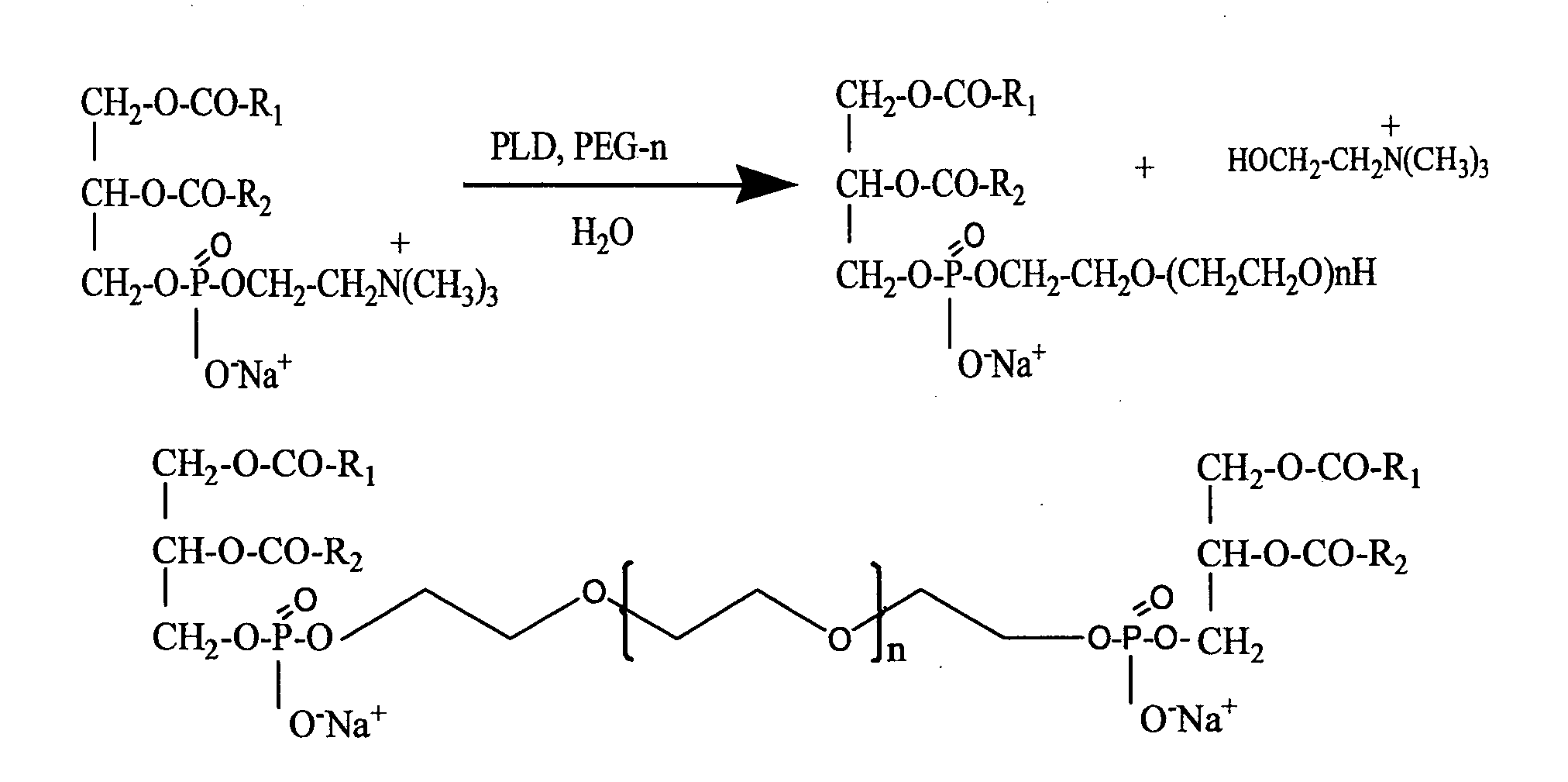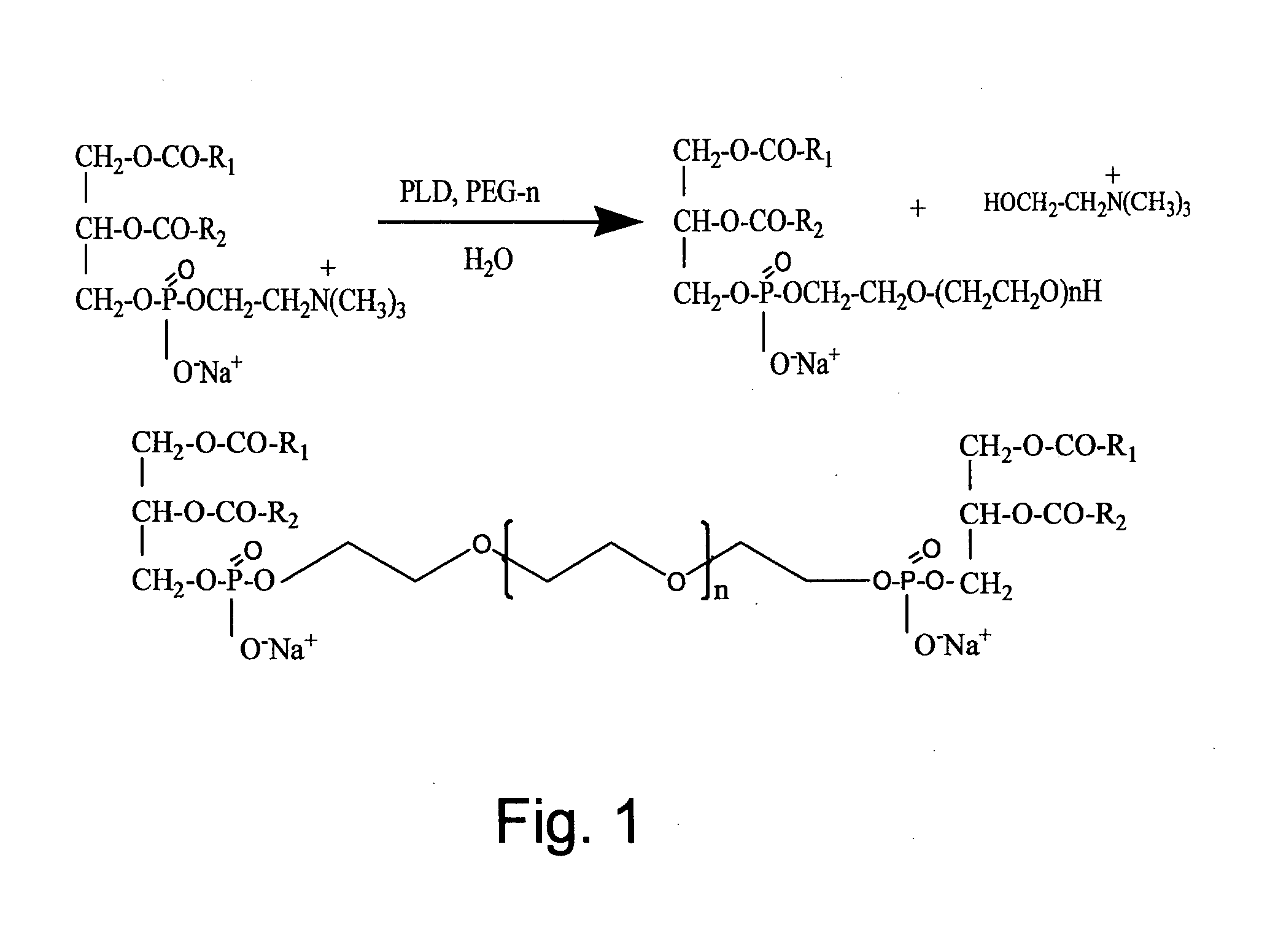Preparation of Heavy Metal-Containing Nano-Liposomes and their Uses in Medical Therapy
- Summary
- Abstract
- Description
- Claims
- Application Information
AI Technical Summary
Benefits of technology
Problems solved by technology
Method used
Image
Examples
example 1
Preparation of a Mixture of Peg-PL and Peg-DPL in a Water System
[0145]Phosphatidyl choline (20 g, PC 98%, Lipoid, Germany) was dissolved in 200 ml of diethyl ether. A water solution (200 ml) containing 50g of PEG of various molecular weights, PEG-200, PEG-400, PEG-600, PEG-1000, PEG-1500, PEG-2000, PEG-4000, PEG-8000 or PEG-12000 (all purchased from Sigma Aldrich®, Israel), 0.5 g of calcium chloride and 10 g of NaCl was prepared. The pH of the solution was preferably adjusted to a value of between pH5 and pH8. Both solutions were charged into a mechanically or magnetically stirred reactor. The trans-phosphatidylation reaction was initiated by the addition of PLD (0.5 g, Meito Sangyo, Japan). The reaction mixture was vigorously stirred for 48 h at 30° C. After completion of the reaction, the mixture was separated into two phases, an organic and an aqueous phase. The organic phase was separated off, using a separation funnel and then washed twice with 200 ml of a solution of water con...
example 2
Preparation of a Mixture of Peg-PL and Peg-DPL in Organic System
[0146]This reaction was performed in two steps:[0147]a. PLD and substrate immobilization: PLD (1 g, Meito Sangyo, Japan) was solubilized in acetate buffer (50 ml) of pH 6.5. The enzyme solution was shaken at room temperature with 10 g enzyme support adsorbent matrix (Amberlite A7, Rhom and Haas, USA) for 5 hours. Although Amberlite A7 was used in this example, silica gel, Celite, ion exchange resin or any adsorbent matrix may be used. The immobilized enzyme was then either filtered off or the solution was decanted to obtain enzyme-loaded wet particles. The wet immobilized enzyme preparation was introduced into a PEG water solution (15 g PEG-400, Sigma-Aldrich, Israel in 15 ml distilled water). The mixture was shaken at room temperature for 2 hours, and then decanted to obtain the wet support loaded with PLD and PEG.[0148]b. The support loaded with PLD and PEG-400 (10 g) which was obtained in step (a) was added into an o...
example 3
Preparation of Stabilized Modified-Gold Complexes
[0149]Gold trichloride (1g of HAuCl4.3H2O, Sigma Aldrich, USA) was dissolved in 50 ml distilled water to give a yellowish solution of acidic pH (below 4). N-Acetyl cysteine (0.5 g of Sigma) was added into the gold solution to yield a precipitate due to formation of water-insoluble gold N-acetyl cysteine complex, at pH values below 6. The pH of this mixture was adjusted to a value above 4.5 with 0.1 M sodium hydroxide, yielding a transparent solution of N-acetyl cysteine-modified gold complex of high solubility in water at pH values above 4.5. This procedure was repeated with different molar ratios of N-acetyl cysteine / gold trichloride, typically at molar ratios of 0.5:1, 1:1, 2:1, 3:1, 4:1, and 6:1, respectively. In all experiments transparent solutions of water soluble complexes were obtained, when the pH of the solution was adjusted to pH values above 4.5. Similarly, gold complexes were also modified with cysteine, methionine, gluta...
PUM
 Login to View More
Login to View More Abstract
Description
Claims
Application Information
 Login to View More
Login to View More - R&D
- Intellectual Property
- Life Sciences
- Materials
- Tech Scout
- Unparalleled Data Quality
- Higher Quality Content
- 60% Fewer Hallucinations
Browse by: Latest US Patents, China's latest patents, Technical Efficacy Thesaurus, Application Domain, Technology Topic, Popular Technical Reports.
© 2025 PatSnap. All rights reserved.Legal|Privacy policy|Modern Slavery Act Transparency Statement|Sitemap|About US| Contact US: help@patsnap.com



